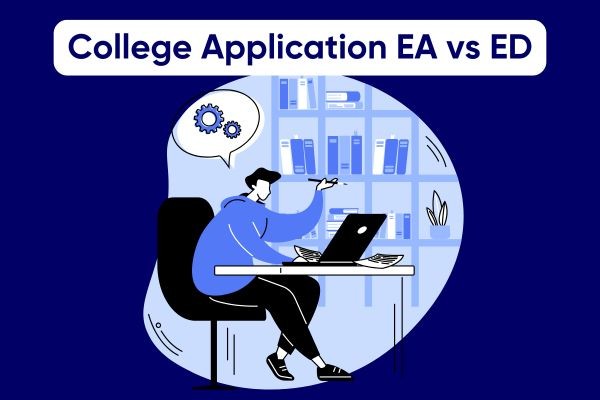The keyword “college application ED vs EA” is in this blog's first sentence. Confused about Early Decision and Early Action? This blog breaks down how ED and EA work, their pros and cons, and how they affect your college chances. You'll also learn when and why to choose one over the other. If you're also thinking about your college admissions timeline, don't forget to check out how to write a Common App essay and how to answer college interview questions!
Disclaimer: Please verify application deadlines and rules with official college websites.
>>Want us to help you get accepted? Schedule a free strategy call here.<<
What Is Early Decision (ED)?
Early Decision (ED) is a way to apply to college before the regular deadlines. If you get accepted, you're committing to go to that school. It's like telling a college: "You're my top choice, and I'm all in."
ED deadlines are usually in November. You apply early, hear back early, and if accepted, you must withdraw all your other applications. It’s binding, which means you’re legally agreeing to attend if admitted, unless the financial aid package doesn’t work for your family.
ED Pros and Cons You Should Know
Pros:
- Shows strong interest
- Potential boost in acceptance rates
- You get your decision sooner
Cons:
- Limited financial aid comparison
- Only one ED application allowed
- High pressure to commit early
What Is Early Action (EA)?
Early Action (EA) also lets you apply early, usually by November, and you hear back in December or January. But it’s non-binding. If accepted, you can still consider other offers.
Like ED, EA deadlines are in the fall. The big difference? You can apply to multiple EA schools (except if one has Restrictive EA), and you don’t have to decide until May.
EA Pros and Cons to Consider
Pros:
- Apply early, hear early
- No obligation to commit
- Compare financial aid offers
Cons:
- No admissions edge at some schools
- Possible confusion with Restrictive EA rules
ED vs EA: What’s the Actual Difference?
Who Should Apply ED?
You should consider ED if:
- You have a clear first-choice school
- You’ve visited and researched it thoroughly
- You’re not relying heavily on financial aid
Who Should Apply EA?
EA makes sense if:
- You’re ready to apply early but not ready to commit
- You want to keep your options open
- You want more time to compare aid offers
How ED and EA Affect Your Chances
Colleges often admit a higher percentage of students in their ED pools. Why? Because these applicants are a guaranteed "yes" if accepted, which helps schools manage their yield rates.
That said, the applicant pool is often stronger too. So yes, ED might give you an edge—but only if you’re already a strong candidate.
ED limits your flexibility. If your financial aid package doesn’t meet your needs, you can appeal or decline, but you won’t be able to compare it to others. EA allows that comparison and might be better if cost is a deciding factor.
Does ED Give You an Edge?
Statistically, yes. But that edge varies by school and applicant profile. It's not a "get in free" pass. Apply ED because you love the school, not because you think it'll be easier.
Here's a comparison of early acceptance rates vs regular acceptance rates at Ivy League colleges:
Should You Apply ED, EA, or Regular Decision?
5 Questions to Ask Yourself First
- Do I have a definite first-choice school?
- Have I visited or researched it thoroughly?
- Am I okay with limited financial aid options?
- Am I academically and emotionally ready to apply early?
- Do I have a backup plan if things don’t work out?
If you’re unsure, don’t rush. Go EA or Regular Decision. It’s better to have choices than to make a premature commitment. Take advantage of college fairs, virtual tours, and campus visits. Connect with admissions officers and ask specific questions about support services, scholarships, and major-specific opportunities. Use these conversations to gauge your fit.
If you apply ED or EA and get deferred, your app moves to the regular pool. Use the extra time to update your application with new grades, achievements, or recommendation letters. If rejected, focus on your other applications without dwelling. Strategically submit updated materials where allowed, and don’t hesitate to seek feedback from your high school counselor.
Strategy Tips for ED/EA Applications
Narrowing Down Your Top Choice
Visit campuses. Talk to current students. Look at programs and values—not just rankings. Your ED school should fit more than just on paper. Ask yourself: Can I see myself here every day? Do I like the campus culture? Are the academic and extracurricular offerings aligned with my goals?
Planning Your Timeline
- Summer: Finalize your college list, begin brainstorming personal statement topics, and start requesting recommendation letters
- August-September: Draft and revise college essays, polish your resume, and complete the Common App or Coalition App sections
- October: Final checks, proofreading, and confirming submission materials
- November: Submit early applications and confirm receipt with colleges
How to Craft a Strong Early App
- Start early. Rushing leads to mistakes.
- Tailor your essays to each school’s values and programs
- Highlight growth and self-awareness in your writing
- Ask for recommendations from teachers who can speak to both your academics and character
- Review your application as if you were an admissions officer: Is your story clear? Are your strengths obvious?
Common Mistakes to Avoid
Misreading Binding Policies. Don't confuse ED with EA. ED means you're committing. If you're not 100% sure you can commit, you should not apply ED—even if the school is prestigious. This is a legal agreement.
Ignoring Financial Factors. Don’t stretch your family’s finances for the sake of a dream school. Run the net price calculator for each college before applying ED. Know your financial safety schools. Have conversations with your parents or guardians early to understand your realistic budget.
Forgetting Backup Plans. Always have Regular Decision schools lined up. ED is not a golden ticket. Build a balanced college list that includes reach, match, and safety schools. Even if you're confident in your early application, don't leave the rest to chance. Stay on top of all deadlines and requirements for your backup schools.
Final Thoughts: What’s Best for You?
ED is best if you're 100% sure and can afford it. EA is better for flexibility and financial comparisons. Neither guarantees admission, so be realistic.
Think about your goals, finances, and readiness. Talk to your family and counselors. Trust your gut—and give yourself options. There’s no one-size-fits-all answer, and that’s okay. Choosing the right path depends on your situation, not anyone else’s.
FAQs
1. What is the main difference between ED and EA?
ED is binding; EA is not. If you apply ED and get in, you must attend. EA lets you decide later.
2. Can I apply to more than one school ED?
No—only one ED application is allowed. Submitting more can result in application withdrawal or worse.
3. Can I apply EA to multiple colleges?
Yes, unless it's Restrictive EA (REA), which limits you to just one early application in some cases.
4. Do ED applicants get better chances?
Often yes, because schools like applicants who are all in. But the pool is usually stronger, so it’s not a free pass.
5. What happens if I get into my ED school but can’t afford it?
You can decline if the financial aid package doesn’t meet your needs, but you must prove financial hardship.
6. Is ED or EA better for financial aid?
EA is better if you want to compare offers from different schools. ED locks you into one.
7. Can I be deferred from ED or EA?
Yes—your app may be moved to the regular pool. Follow up with updates and a letter of continued interest.
8. What if I’m not sure about my top choice school yet?
Stick with EA or Regular Decision. Give yourself more time to research and visit schools before deciding.
To your success,
Your friends at BeMo


Like our blog? Write for us! >>
Have a question? Ask our admissions experts below and we'll answer your questions!
Comments